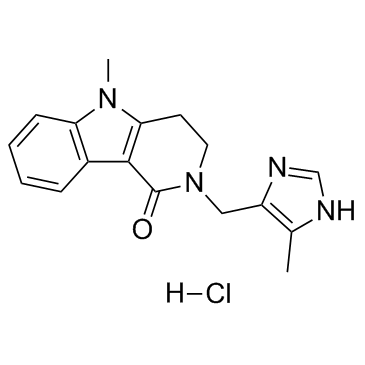Alosetron, cilansetron and tegaserod modify mesenteric but not colonic blood flow in rats.
Evelin Painsipp, Anaid Shahbazian, Peter Holzer
文献索引:Br. J. Pharmacol. 158(5) , 1210-26, (2009)
全文:HTML全文
摘要
As the use of the 5-HT(3) receptor antagonist alosetron (GlaxoSmithKline) and the 5-HT(4) receptor agonist tegaserod (Novartis) in patients with irritable bowel syndrome has been associated with cases of ischaemic colitis, the effects of alosetron, cilansetron (Solvay) and tegaserod on the rat splanchnic circulation were evaluated.Phenobarbital-anaesthetised rats were instrumented to record blood flow in the superior mesenteric artery and transverse colon and to calculate mesenteric and colonic vascular conductance.Intravenous alosetron (0.03-0.3 mg.kg(-1)) did not alter blood pressure or heart rate but reduced mesenteric blood flow and vascular conductance by 15-20%. This activity profile was also seen after intraduodenal alosetron and shared by the 5-HT(3) receptor antagonist cilansetron. In contrast, blood flow, vascular conductance and intraluminal pressure in the colon were not modified by alosetron and cilansetron. Intravenous or intraduodenal tegaserod (0.3-1.0 mg.kg(-1)) had no inhibitory effect on mesenteric and colonic blood flow. Peroral treatment of rats with alosetron or tegaserod for 7 days did not modify mesenteric haemodynamics at baseline and after blockade of nitric oxide synthesis. Mild inflammation induced by dextran sulphate sodium failed to provoke a vasoconstrictor effect of cilansetron in the colon.Alosetron and cilansetron, not tegaserod, caused a small and transient constriction of the rat mesenteric vascular bed, whereas blood flow in the colon remained unaltered. The relevance of these findings to the treatment-associated occurrence of ischaemic colitis in patients with irritable bowel syndrome remains open.
相关化合物
| 结构式 | 名称/CAS号 | 分子式 | 全部文献 |
|---|---|---|---|
 |
盐酸阿洛司琼
CAS:122852-69-1 |
C17H19ClN4O |
|
In silico binary classification QSAR models based on 4D-fing...
2010-07-26 [J. Chem. Inf. Model. 50(7) , 1304-18, (2010)] |
|
Quantitative benefit-risk assessment using only qualitative ...
2012-01-01 [Med. Decis. Making 32(6) , E1-15, (2012)] |
|
Clinical trials in irritable bowel syndrome: a review.
2013-03-01 [Rev. Recent Clin. Trials 8(1) , 9-22, (2013)] |
|
Quality of life in patients with irritable bowel syndrome.
2011-08-01 [J. Clin. Gastroenterol. 45 Suppl , S98-101, (2011)] |
|
Efficacy and tolerability of alosetron for the treatment of ...
2008-05-01 [Clin. Ther. 30(5) , 884-901, (2008)] |